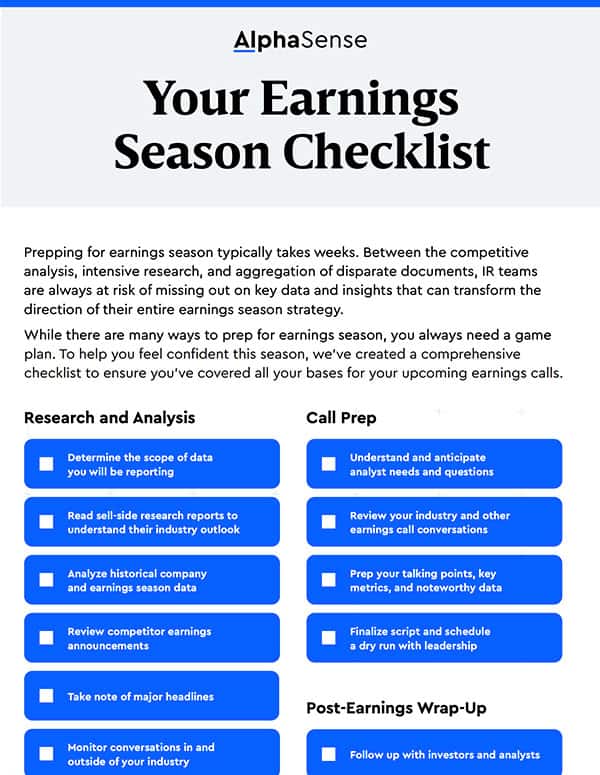There are several reasons for a company to preannounce its financial results, or provide the Street with a preliminary, high-level understanding of what the company’s quarterly performance will be.
Typically, a pre-announcement is made in the weeks preceding the full earnings release and conference call. Management also may decide to update investors with preliminary results ahead of investor days, investment conferences and major acquisitions. This allows conversation on current financials without violating Regulation Fair Disclosure.
The question is more complex than simply whether to make a preannouncement, however. Many considerations contribute to the decision on what information to include — and whether to produce an early release at all.
Preannouncing Earnings – What’s the Rationale?
We decided to run an AlphaSense search to get a snapshot of the prevailing trends and rationale for early announcement. AlphaSense uses a blend of advanced linguistic search and NLP algorithms to help research professionals to search, navigate, and analyze corporate filings and other disclosures for critical data points.
We looked at a sample of 59 preannouncement releases that had been issued in the U.S..
We examined:
- The rationale stated for issuing the announcement
- Metrics the companies provided, the sentiment of the announcements
- Whether the companies provided/updated guidance
- The presence (or absence) of reconciliation tables for non-GAAP guidance metrics
- The amount of discussion the firms provided beyond basic financial data
Among our sample:
- 37% explicitly stated that they were issuing preliminary results because they were updating their previous guidance
- 19% had not provided guidance, but our research showed us that they had missed or beaten analyst expectations and were presumably providing a warning to the Street
- 17% preannounced in conjunction with an acquisition announcement
- 12% issued the release prior to an investor event (conference presentation, 9%; investor day, 3%)
The remaining 5% of the sample offered no information as to the catalysts behind the release.
Where’s the Consensus?
So why didn’t any of the companies that missed or beat the Street simply refer to the analysts’ consensus expectations?
There are two reasons why the absence of any mention of analysts’ consensus estimates, whether it be in the final earnings release, a results preannouncement, or any other type of management commentary, is best practice.
- By commenting favorably on analysts’ estimates, management is essentially endorsing those estimates. What happens the next time an analyst changes his or her forecast? Will management comment again, and every time thereafter?
- By commenting negatively on consensus, management still creates an expectation it will provide updates on analysts’ estimates in the future. If management does not comment on future estimate revisions, it presents a no-man’s land. Given its lack of commentary, investors are left to decide for themselves whether management still disagrees with the consensus, or implicitly agrees with the Street.
The unspoken word here is “guidance”
Any comment on a third-party’s estimate or commentary regarding future company performance can be interpreted to constitute guidance. For companies that already provide their own guidance, commenting on third-party estimates creates a potential conflict if consensus and management guidance are not aligned. Companies that have a policy of not issuing guidance violate that policy by opining at all, and now they have created a situation they never wanted to be in in the first place.
This brings us back to our initial question: Should companies preannounce their financial results? By issuing an early announcement in a press release, companies advise investors and analysts of potential surprises ahead of time. This enhances goodwill with the investment community and may protect the stock against wider swings after an earnings estimate miss. By placing that announcement in a press release, companies fulfill the “broad dissemination” requirement of Regulation FD. This enables management to provide all investors with the same information. It also guards against news being released inadvertently to individual third parties.
Popular metrics listed in earnings preannouncements
When preannouncing financial results, companies need to determine the preliminary financial metrics they will disclose.
We’ve broken out by category the metrics the sample companies disclosed in their preannouncements. Among this group, the most popular metrics included:
- Sales or revenue
- Net income or EPS (either GAAP or non-GAAP)
- EBITDA
- Cash balance or quarterly operating cash
- Gross profit / margin
- Operating income or expense
When providing preliminary results, companies can only provide the information in which they have a reasonable level of confidence.
Accrual accounting notwithstanding, revenue figures do not tend to move much once a quarter is completed. Profit, on the other hand, is a function of several other inputs and is generally a more intricate calculation. If providing a bottom-line figure in the preannouncement, we consider it best practice to provide a preliminary range management has confidence in, so that investors are not surprised twice.
Providing a rationale
Once management determines which metrics to provide, it should then decide on the type and amount of messaging it wants to use in support of the financial data. Using AlphaSense, it is easy to examine specific messaging companies used to explain results.
The importance of context
Why would companies not provide more “color” around the results? The additional information would certainly be more helpful for investors, wouldn’t it?
In our view, it would, but there is some nuance here. First, we begin with the assumption that the company is preannouncing in order to assist investors. That is the best perspective from which to decide to preannounce, but it is not the only one. Management may issue the release solely to fulfill the “broad dissemination” requirement under Regulation FD. Example situations of when this might be the case could include remediation of selective disclosure of non-public material information or the issuance of preliminary results in advance of an equity offering or M&A deal.
As the percentages demonstrate, however, strictly stating the numbers is not the prevailing approach. The other 80% of our sample gave at least some rationale for the companies’ performance. This was in the form of additional color — via external events, industry trends and corporate strategies. Approximately two-thirds of the companies provided that color in the form of a quote from the CEO, but for our purposes, whether the information appeared between quotation marks is not particularly relevant. What is important is to provide investors with a reason for the early announcement and a frame of reference for the results.
The bottom line
The key word here is context. Beyond fulfilling a regulatory requirement, a preannouncement is an important way to communicate unexpected results and events with investors en masse. It provides management with a platform to get ahead of an earnings surprise by communicating its message first. Elaborating on the factors that influenced the company’s performance is essential to providing investors with the proper understanding.
David Calusdian, the Executive Vice President and a Partner at Sharon Merrill, oversees the implementation of investor relations programs, coaches senior executives in presentation skills and provides strategic counsel to clients on numerous communications issues such as corporate disclosure, proxy proposals, shareholder activism and earnings guidance.
This post was originally published in 2016 and has been updated regularly to reflect new information/data.
.png)








